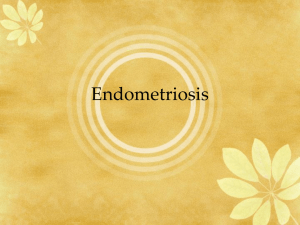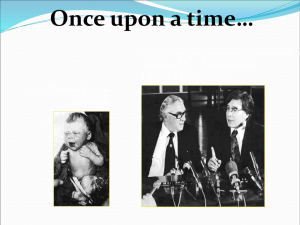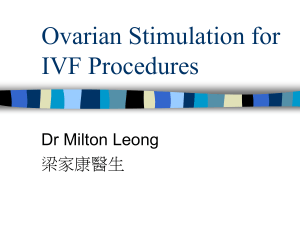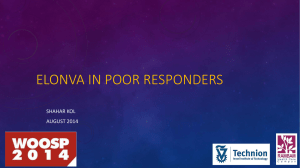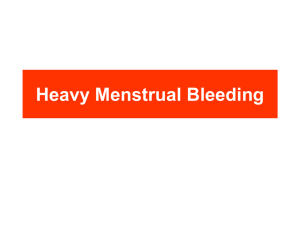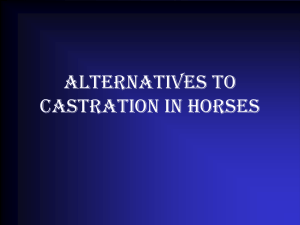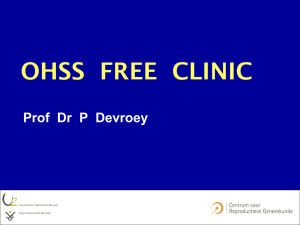Mohamed Youssef
advertisement
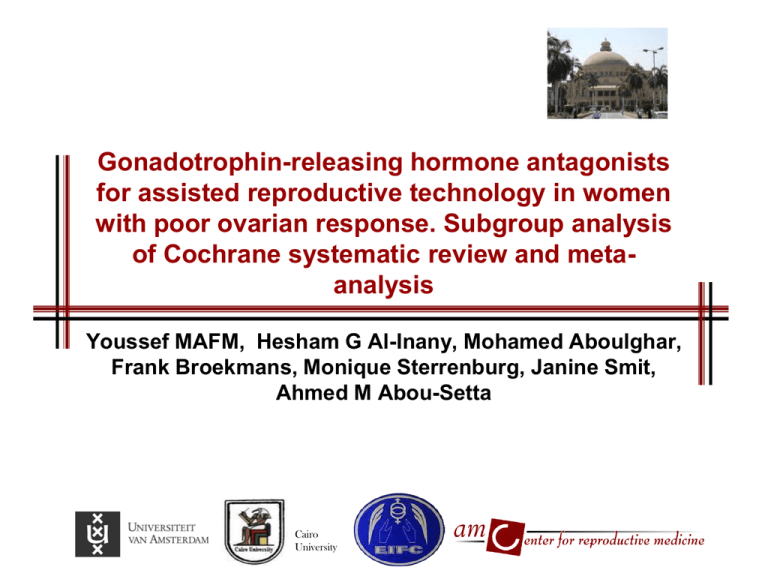
Gonadotrophin-releasing hormone antagonists for assisted reproductive technology in women with poor ovarian response. Subgroup analysis of Cochrane systematic review and metaanalysis Youssef MAFM, Hesham G Al-Inany, Mohamed Aboulghar, Frank Broekmans, Monique Sterrenburg, Janine Smit, Ahmed M Abou-Setta Cairo University What is the problem ? • ≈ 9-24% of IVF/ICSI patients respond poorly to ovarian stimulation !!! Poor ovarian responders Natural Populations ART Populations Is there a treatment for poor ovarian responders ? Different treatment options 1. Various Pituitary down regulation protocols & 2. High dose or mild dose of Gn. Pituitary downregulation protocols 1. Short GnRH agonist 2. Long GnRH agonist 3. GnRH antagonist 4. Natural cycle Long GnRH agonist Long GnRH agonist is the standard protocol used for poor responders, however, this protocol has many drawbacks: 1. Prolonged duration of ovarian stimulation, 2. Multiple injections, 3. More patient’s distress 4. Increased the cost without improving IVF outcome kasr al ainy school of Medicine Cairo University GnRH antagonist protocol • Last decade, GnRH antagonist has been emerged as an alternative to GnRH agonist protocols in IVF/ICSI cycles. • GnRH antagonists competitively desensitize pituitary GnRH receptors immediate & reversible suppression of gonadotropin secretion kasr al ainy school of Medicine Cairo University GnRH antagonist protocol Due to these pharmacokinetic characteristics it was anticipated that, GnRH antagonists are an optimal alternative to long GnRH agonist because their use occurs after the commencement of gonadotropin stimulation, thus theoretically:1. Minimizing their impact on early follicular recruitment 2. Reduces suppression of endogenous gonadotrophins . kasr al ainy school of Medicine Cairo University GnRH antagonist protocol GnRH antagonist might have many advantages over GnRH agonist such as:1. Fewer injections, 2. Shorter duration of stimulation, 3. Less incidence of OHSS. kasr al ainy school of Medicine Cairo University GnRH antagonist protocol So it has been promised to be more patient friendly than long GnRH agonist in general, however, there is a great controversy about its impact on responders kasr al ainy school of Medicine Cairo University pregnancy outcomes in poor Aim of the review • The aim of this subgroup analysis of the recently published Cochrane review was to compare GnRH antagonist desensitization protocol with the standard long GnRH agonist in women with poor ovarian response undergoing IVF/ICSI treatment cycles kasr al ainy school of Medicine Cairo University Inclusion criteria • Type of studies: RCT • Participants: Infertile couples with poor ovarian response undergoing IVF/ICSI • Intervention: Long GnRH agonist protocol versus GnRH antagonist protocol for pituitary downregulation kasr al ainy school of Medicine Cairo University Outcomes • Primary outcome: Ongoing pregnancy rate • Secondary outcomes: 1. Clinical pregnancy rate 2. Duration of ovarian stimulation & amount of Gonadotropin used, 3. Number of retrieved oocytes 4. Cycle cancellation rate kasr al ainy school of Medicine Cairo University Literature search • • • • • • • • • Menstrual Disorders & Subfertility Group's Specialised Register of controlled trials The Cochrane Central Register of Controlled Trials (CENTRAL) MEDLINE (1966 to Jan 2011) EMBASE (1980 to Jan 2011) National Research Register Web-based trials databases such as Current Controlled Trials References check. We also contacted drug companies for any published, unpublished or ongoing studies not identified with our search strategy No language restriction kasr al ainy school of Medicine Cairo University Results Flow diagram of study selection Potentially relevant publications identified and screened for retrieval (n= 25) Publications excluded, (n= 19) RCTs included in meta-analysis (n=6) RCTs withdrawn (n=0) RCTs with usable information (n=6) 1. 2. 3. 4. 5. 6. Inza 2004 Cheung 2005 Marci 2005 Tazegul 2008 Kim 2009 Sbarcia 2009 kasr al ainy school of Medicine Cairo University Ongoing pregnancy rate GnRH antagonist Study or Subgroup Long GnRH agonist Odds Ratio Events Total Events Cheung 2005 3 33 3 33 23.7% Marci 2005 4 30 0 30 Tazegul 2008 8 48 10 Total (95% CI) Total events 111 15 Heterogeneity: Chi² = 2.79, df = 2 (P = 0.25); I² = 28% Test for overall effect: Z = 0.40 (P = 0.69) Odds Ratio Total Weight M-H, Fixed, 95% CI M-H, Fixed, 95% CI 1.00 [0.19, 5.36] 3.7% 10.36 [0.53, 201.45] 48 72.5% 0.76 [0.27, 2.13] 111 100.0% 1.17 [0.53, 2.58] 13 0.01 0.1 1 10 100 Long GnRH agonist GnRH antagonist Clinical pregnancy rate GnRH antagonist Study or Subgroup Long GnRH agonist Odds Ratio Events Total Events Cheung 2005 5 33 3 33 3.6% 1.79 [0.39, 8.17] Inza 2004 7 23 9 22 9.2% 0.63 [0.18, 2.16] Kim 2009 15 54 7 28 9.5% 1.15 [0.41, 3.27] 5 30 2 30 2.4% 2.80 [0.50, 15.73] Sbarcia 2009 25 285 48 285 62.8% 0.47 [0.28, 0.79] Tazegul 2008 10 48 11 48 12.5% 0.89 [0.34, 2.33] 446 100.0% 0.71 [0.49, 1.02] Marci 2005 Total (95% CI) Total events 473 67 Heterogeneity: Chi² = 7.26, df = 5 (P = 0.20); I² = 31% Test for overall effect: Z = 1.86 (P = 0.06) Total Weight Odds Ratio M-H, Fixed, 95% CI M-H, Fixed, 95% CI 80 0.01 0.1 1 10 100 Long GnRH agonist GnRH antagonist No. retrieved oocytes GnRH antagonist Study or Subgroup Mean Cheung 2005 Long GnRH agonist SD Total Mean 5.89 3.02 Mean Difference SD Total Weight IV, Fixed, 95% CI 33 5.6 4.17 33 4.8 2 54 4.7 2.1 28 10.9% 0.10 [-0.84, 1.04] Marci 2005 5.6 1.6 30 4.3 2.2 30 10.2% Sbarcia 2009 3.7 2.5 285 4.3 2.4 285 59.9% -0.60 [-1.00, -0.20] 5.44 1.29 48 5.47 2.45 48 15.8% -0.03 [-0.81, 0.75] Total (95% CI) 450 Heterogeneity: Chi² = 13.78, df = 4 (P = 0.008); I² = 71% Test for overall effect: Z = 1.33 (P = 0.18) IV, Fixed, 95% CI 3.1% 0.29 [-1.47, 2.05] Kim 2009 Tazegul 2008 Mean Difference 1.30 [0.33, 2.27] 424 100.0% -0.21 [-0.52, 0.10] -1 -0.5 0 0.5 1 Long GnRH agonist GnRH antagonist Cancellation rate GnRH antagonist Study or Subgroup Long GnRH agonist Odds Ratio Events Total Events Cheung 2005 2 33 1 33 10.0% 2.06 [0.18, 23.94] Kim 2009 2 15 1 7 12.6% 0.92 [0.07, 12.28] Marci 2005 1 5 2 2 26.6% 0.07 [0.00, 2.33] Sbarcia 2009 4 25 7 48 42.8% 1.12 [0.29, 4.25] Tazegul 2008 2 10 1 11 8.1% 2.50 [0.19, 32.80] 101 100.0% 1.02 [0.41, 2.51] Total (95% CI) Total events 88 11 Heterogeneity: Chi² = 3.07, df = 4 (P = 0.55); I² = 0% Test for overall effect: Z = 0.04 (P = 0.97) Total Weight Odds Ratio M-H, Fixed, 95% CI M-H, Fixed, 95% CI 12 0.01 0.1 1 10 100 Long GnRH agonist GnRH antagonist Duration of stimulation GnRH antagonist Study or Subgroup Mean Difference SD Total Mean SD 10.5 2.7 33 11.5 2.4 33 Kim 2009 10 1.4 54 11.6 1.7 28 10.9% -1.60 [-2.33, -0.87] Marci 2005 9.8 0.8 30 14.6 1.2 30 21.9% -4.80 [-5.32, -4.28] Sbarcia 2009 11.3 1.8 285 12 2.1 285 56.6% -0.70 [-1.02, -0.38] Tazegul 2008 10.6 1.63 48 12.03 2.86 Cheung 2005 Total (95% CI) Mean Long GnRH agonist 450 Heterogeneity: Chi² = 177.28, df = 4 (P < 0.00001); I² = 98% Test for overall effect: Z = 14.26 (P < 0.00001) Total Weight 48 Mean Difference IV, Fixed, 95% CI IV, Fixed, 95% CI 3.8% -1.00 [-2.23, 0.23] 6.7% -1.43 [-2.36, -0.50] 424 100.0% -1.76 [-2.00, -1.52] -4 -2 0 2 4 Long GnRH agonist GnRH antagonist Amount of Gonadotropins GnRH antagonist Long GnRH agonist Study or Subgroup Mean SD Total Mean SD Total Weight Cheung 2005 3,150 813 33 3,445 730 33 14.5% -295.00 [-667.79, 77.79] Kim 2009 2,963.9 433.1 54 3,390.2 443.2 28 50.1% -426.30 [-627.03, -225.57] Marci 2005 18,487.5 1,612.5 30 27,225 2,550 30 Sbarcia 2009 2,686 1,994 285 3,018 1,989 Tazegul 2008 2,467.7 342.4 Total (95% CI) 48 3,872.683 1,257.1 450 Heterogeneity: Chi² = 243.42, df = 4 (P < 0.00001); I² = 98% Test for overall effect: Z = 9.36 (P < 0.00001) Mean Difference IV, Fixed, 95% CI Mean Difference IV, Fixed, 95% CI 1.7% -8737.50 [-9817.12, -7657.88] 285 18.9% -332.00 [-658.98, -5.02] 48 14.8% -1404.98 [-1773.57, -1036.40] 424 100.0% -678.54 [-820.55, -536.53] -1000 -500 0 500 1000 Long GnRH agonist GnRH antagonist Studies characteristics The overall methodological quality of the trials was:1. Good 2. Published as a full manuscript in peer-reviewed journals. 3. The studies were generally small and not well powered for all the clinical relevant outcomes. 4. In five of six randomized trials, concealment of allocation was not clearly described 5. In three studies there was no blinding and in two studies it was unclearly reported 6. An intention to treat analysis was stated to have been carried out in only one study Results • Consistencies were found among the studies in outcomes such as OPR, CPR & cancellation rate • There were Inconsistencies between studies in outcomes such as number of oocytes, duration of stimulation and amount of Gn used. Summary of results The present meta-analysis indeed suggests that GnRH antagonist in poor responders result in:1. ≈ Comparable pregnancy rates 2. ≈ Comparable number of retrieved follicles 3. ≈ Comparable cancellation rate 4. Shorter duration of stimulation 5. Less amount of Gn kasr al ainy school of Medicine Cairo University Take home message • In view of its equivalence, GnRH antagonist is an alternative for long GnRH agonist in poor responder patients undergoing stimulation and IVF/ICSI cycles kasr al ainy school of Medicine Cairo University ovarian Results Although the inconsistency of studies ‘results in a meta-analysis reduces the confidence of recommendations about treatment, it is an expected due to clinical and methodological diversity between studies such as inclusion criteria for participation and study quality but it cannot be regarded as a major cause of the differences in the results of the studies included in this subgroup analysis
